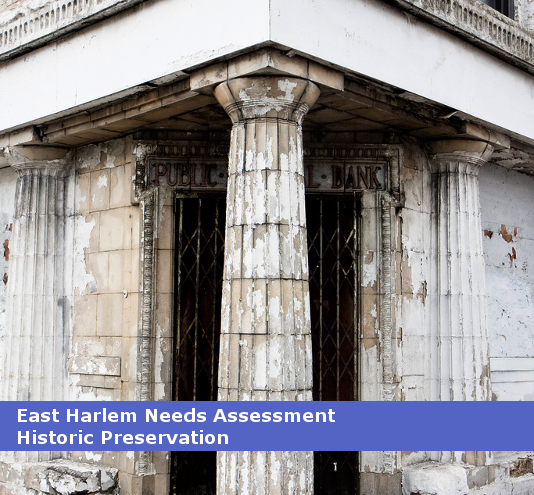 Several groups have assessed the need for historic preservation in East Harlem. Here we present key findings and recommendations.
Several groups have assessed the need for historic preservation in East Harlem. Here we present key findings and recommendations.
Findings:
- Propose East Harlem Historic District be certified eligible for National Register eligible, nominate 19 Individual Landmarks and two Historic Districts, the East Harlem Historic District and the Early East Harlem Historic District, to NYC Landmarks Preservation Commission, and amend current zoning to compliment these Districts
- Major themes included: need for appropriate supportive services; health care access and financial challenges; beliefs related to stigma, trust, and accountability; and the impact of the physical environment on health. Education was seen as a critical area of need and intervention.
- Structured observation identified many sidewalks in disrepair or obstructed, few benches, and highly variable times allocated for pedestrians to cross at cross walks
- East River waterfront viewed as site with great potential for development, particularly as a waterfront esplanade.
- Land use – Responses relating to size and scale of local development issues included vacant lots and abandoned buildings, existing public housing and a desire for more affordable housing.
- Transportation – Respondents recognized a need for more transit options; respondents were only somewhat satisfied with the reliability of service. Respondents expressed concerns about number of pot holes, trash pickup, turn signals, speeding motorists, crosswalk safety, sidewalk conditions and sidewalk obstructions.
- Environmental Quality – concern about the air quality, water quality, marine transfer station, noise pollution, street cleaning and trash collection in both neighborhoods. Several respondents mentioned negative health impacts, particularly asthma, and the burning of heating oil.
- Streetscape – Most frequent comment was a request for more trees.
Recommendations:
- Increase street tree stocking level from 63% to 90% by 2030;
- Increase tree survival.
- Establish programs that increase the community’s appreciation for street trees.
- Identify policies that influence the urban forest.
- Track progress on the overall vision and action items specified in this plan.
- Design and construct a walking tour of East Harlem. The tour will be marked by tree-lined streets, art, and signs.
- Programming that encourages sustained interest in the walk will be advertised through the print media, public events and the Internet.

